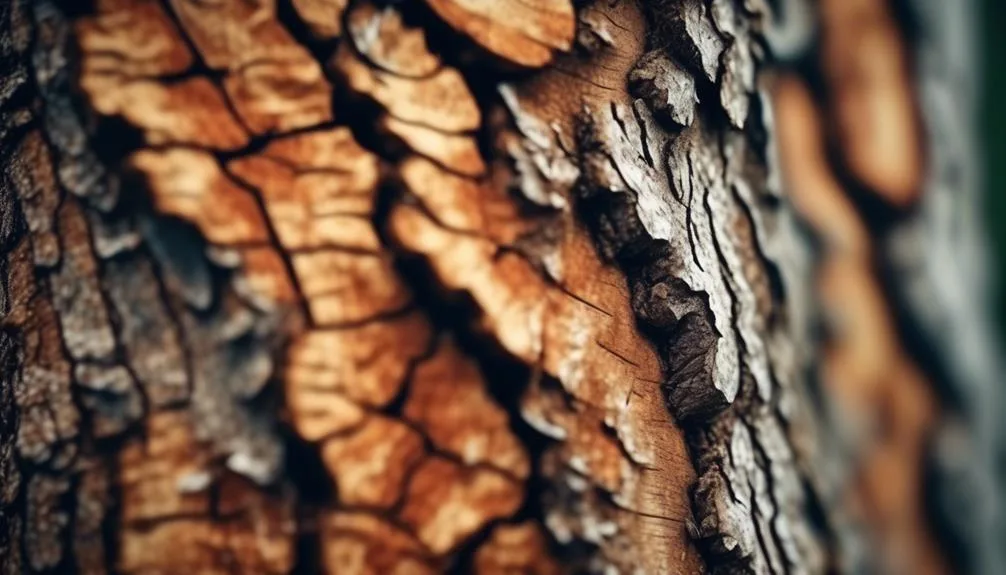Ever noticed how the bark of a spruce tree peels and cracks? It's quite intriguing, right?
But have you wondered why it happens? From environmental factors to pests and diseases, the reasons behind this phenomenon are diverse.
If you've ever pondered about nature's mysteries and the life of a spruce tree, get ready for an exploration into the world of botany and ecology.
Environmental Factors
Environmental factors can significantly impact the peeling and cracking of spruce tree bark. Climate change and temperature fluctuations are key contributors to this issue. When the temperature fluctuates dramatically, the bark experiences stress and may crack or peel. The expansion and contraction of the bark during these fluctuations can result in fissures and peeling. Moreover, soil moisture levels and drought stress also play a crucial role in the health of spruce tree bark. Drought stress weakens the bark, making it more vulnerable to peeling and cracking. To better care for spruce trees and minimize the impact of these stressors, it is important to understand these environmental factors. By addressing climate change, temperature fluctuations, soil moisture, and drought stress, you can effectively maintain the health and integrity of your spruce tree's bark.
Tree Age and Growth
The age and growth of spruce trees significantly impact the development and integrity of their bark, influencing factors such as peeling and cracking. Understanding these aspects can provide valuable insights into the health and resilience of these majestic trees.
Here's how tree age and growth affect spruce tree bark:
- Bark Regeneration: As spruce trees age, the bark undergoes natural wear and tear. Younger trees have smoother, more flexible bark that can heal and regenerate more effectively, while older trees may struggle to renew their bark, leading to peeling and cracking.
- Growth Rings: Examining the growth rings of a spruce tree can reveal its age and growth patterns. Each ring represents a year of growth and can indicate periods of stress, which may impact bark health and integrity.
- Environmental Adaptation: Over time, spruce trees adapt to their environment, with bark thickness and composition changing as the tree matures. This adaptation can influence the susceptibility of the bark to peeling and cracking.
Natural Adaptation Processes
Aging spruce trees naturally undergo adaptation processes that directly impact the resilience and durability of their bark, influencing factors such as peeling and cracking. One of these processes is bark shedding, where the outer bark layer is shed as the tree grows, allowing it to discard damaged or diseased tissues and maintain a healthy protective layer. Another crucial process is bark regrowth, where the tree's inner tissues generate new bark to replace what was shed, ensuring continued protection and structural support. These adaptation processes are vital for the tree's survival, as they contribute to the renewal and maintenance of the bark, helping the spruce tree withstand environmental stressors and thrive in its habitat.
| Adaptation Processes | Impact |
|---|---|
| Bark Shedding | Shedding damaged or diseased tissues |
| Bark Regrowth | Renewal of protective bark layer |
Impact of Pests and Diseases
Pests and diseases can significantly weaken the resilience of spruce tree bark, leading to increased susceptibility to environmental stressors and compromising the tree's overall health and longevity.
Here's how they impact the spruce tree:
- Bark damage: Pests such as bark beetles can bore into the bark, creating entry points for diseases and causing extensive damage. This weakens the bark's protective function, making the tree more vulnerable to environmental stressors.
- Tree health: Diseases like needle rust and cytospora can weaken the tree's immune system, making it less capable of defending against other stressors. This can lead to overall deterioration in the tree's health, affecting its growth and vitality.
- Long-term impact: If left unchecked, pests and diseases can lead to severe bark damage and long-term decline in tree health, potentially resulting in the eventual death of the spruce tree.
Understanding the impact of pests and diseases is crucial in preserving the health and resilience of spruce trees.
Human Interference and Maintenance
Regular maintenance and care practices play a crucial role in preserving the health and longevity of spruce trees. Proper pruning techniques can prevent bark damage and promote healthy growth. Additionally, addressing soil compaction is essential for maintaining tree stability. Here are some key maintenance practices to consider:
| Maintenance Practice | Description | Benefits |
|---|---|---|
| Pruning techniques | Regularly trim dead or diseased branches to prevent bark damage and promote healthy growth. | Prevents bark damage, encourages healthy growth. |
| Soil compaction | Use aeration techniques to relieve soil compaction, allowing the tree's roots to receive necessary nutrients and water. | Improves soil quality, enhances tree stability. |
| Tree stability | Regularly assess and support tree stability through techniques such as cabling or bracing. | Reduces risk of tree damage, enhances safety. |
Implementing these practices will contribute to the overall health and well-being of spruce trees.
Conclusion
Understanding the reasons behind spruce tree bark peeling or cracking sheds light on the intricate interplay of environmental factors, tree resilience, and human impact.
Observing nature's adaptability invites us to appreciate the remarkable ways in which trees navigate their surroundings.
What other natural marvels await our curiosity and discovery?

My interest in trees started when I first saw the giant sequoias in Yosemite.
I was a teenager then, and I remember thinking, “I need to learn more about this.”
That moment stuck with me.
A few years later, I went on to study forestry at Michigan Tech.
Since graduating, I’ve worked in a mix of hands-on tree care and community education.
I’ve spent over ten years helping people understand how to plant, maintain, and protect the trees in their neighborhoods.
I don’t see trees as just part of the landscape.
They are living things that make a real difference in our daily lives.
